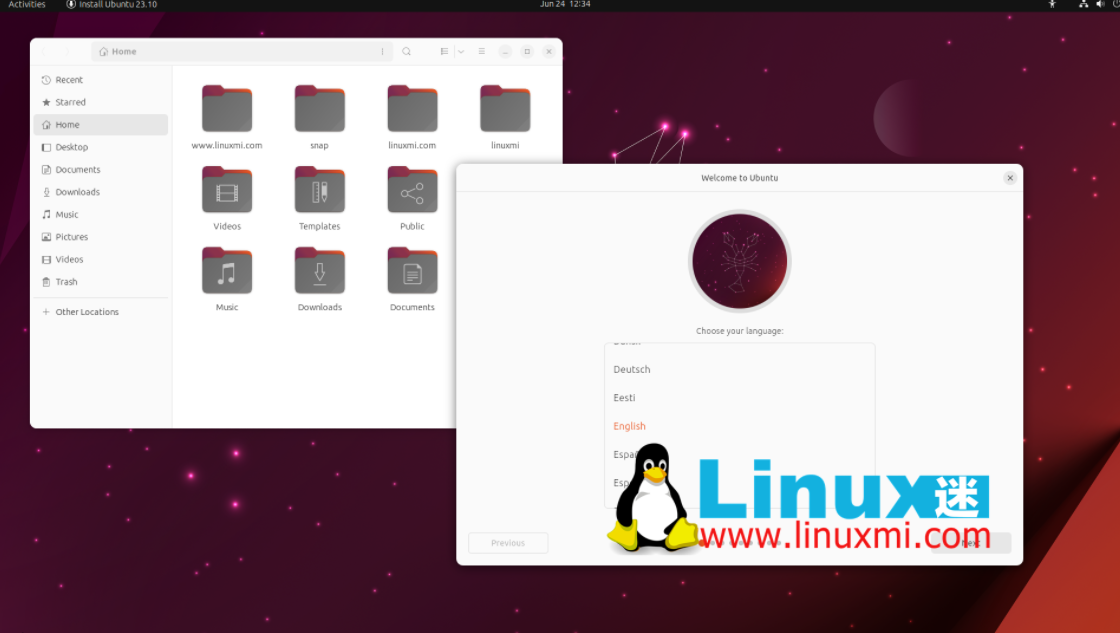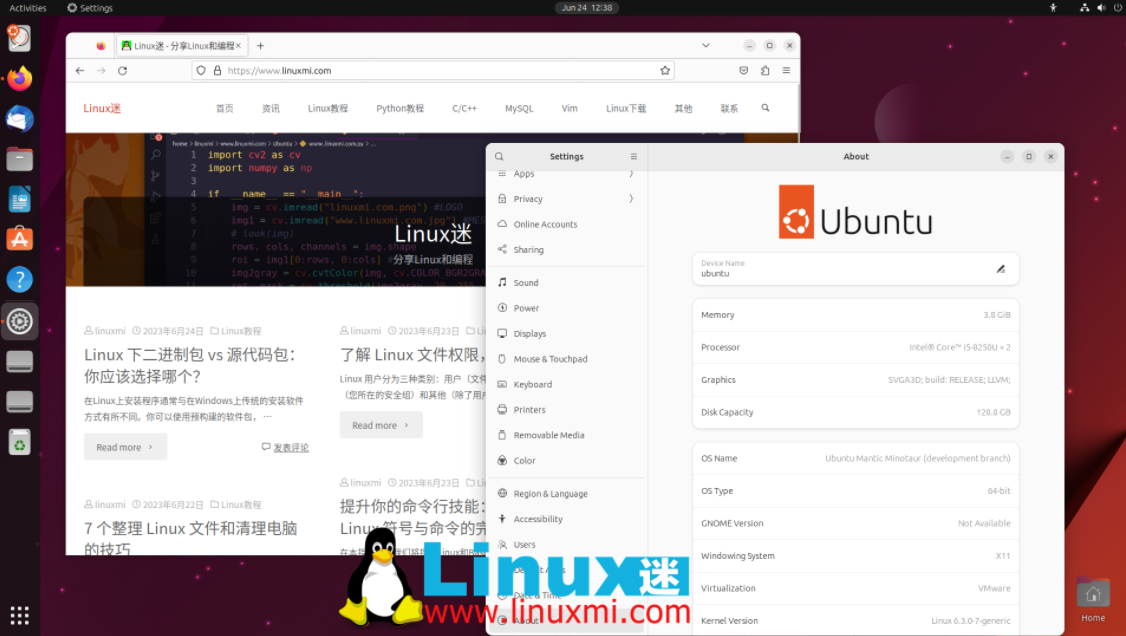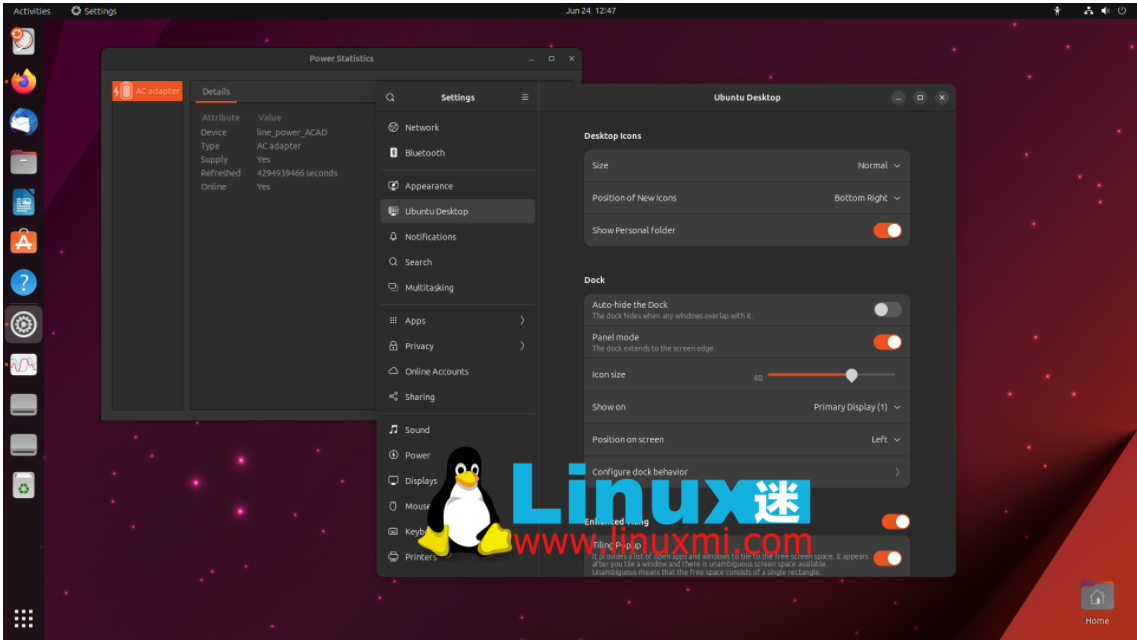Ubuntu 23.10 is now powered by the incredibly powerful Linux Kernel 6.3
Ubuntu 23.10 (Mantic Minotaur) is designed for users who want to experience the latest Linux 6.3 kernel series in Ubuntu systems.
Recently, there is exciting news: this version will be re-based on the Linux 6.3 kernel. It is reported that the development of Ubuntu 23.10 began in late April this year and is based on the current interim version Ubuntu 23.04 (Lunar Lobster).
This means that the initial daily build ISO image will be essentially the same as the core components and applications, including the Linux 6.2 kernel from previous releases. Such modifications allow users to easily enjoy the new features and optimizations brought by the latest Linux 6.3 kernel. 
Now, two months into the development cycle, the latest Ubuntu 23.10 daily build ISO image is powered by Linux 6.3. This is good news for those planning to install the upcoming Ubuntu version on their PCs and want to test their hardware's compatibility with Linux 6.3.
I have to admit that the kernel rebasing was pretty quick, but it's still a good move, especially since Ubuntu 23.04's Linux 6.2 kernel has reached end-of-life. Rest assured that Linux 6.3 will not be the final kernel included in the final Mantic Minotaur release, which will be released in late October 2023.

Linux kernel 6.4 is likely to be released this weekend, and the next major kernel series, Linux 6.5, is expected to enter the development stage in mid-July 2023. This version is likely to be a good example of the final release of Ubuntu 23.10 Select, as this version is expected to be released in late August or early September 2023.
The Ubuntu kernel team will have nearly two months to test and re-base Ubuntu 23.10 on Linux 6.5 to provide users with best-in-class hardware support. However, we still need to wait for their decision.

In addition to the latest GNU/Linux technology, Ubuntu 23.10 (Mantic Minotaur) will also feature the upcoming GNOME 45 desktop environment series, expected to be released in late September 2023.
If you want to try the latest development snapshot of Ubuntu 23.10 on your PC, you can download the latest daily build ISO from the official download server. But please keep in mind that this is a pre-release version and should not be used or installed in a production environment.
The above is the detailed content of Ubuntu 23.10 is now powered by the incredibly powerful Linux Kernel 6.3. For more information, please follow other related articles on the PHP Chinese website!

Hot AI Tools

Undresser.AI Undress
AI-powered app for creating realistic nude photos

AI Clothes Remover
Online AI tool for removing clothes from photos.

Undress AI Tool
Undress images for free

Clothoff.io
AI clothes remover

Video Face Swap
Swap faces in any video effortlessly with our completely free AI face swap tool!

Hot Article

Hot Tools

Notepad++7.3.1
Easy-to-use and free code editor

SublimeText3 Chinese version
Chinese version, very easy to use

Zend Studio 13.0.1
Powerful PHP integrated development environment

Dreamweaver CS6
Visual web development tools

SublimeText3 Mac version
God-level code editing software (SublimeText3)

Hot Topics
 Linux Architecture: Unveiling the 5 Basic Components
Apr 20, 2025 am 12:04 AM
Linux Architecture: Unveiling the 5 Basic Components
Apr 20, 2025 am 12:04 AM
The five basic components of the Linux system are: 1. Kernel, 2. System library, 3. System utilities, 4. Graphical user interface, 5. Applications. The kernel manages hardware resources, the system library provides precompiled functions, system utilities are used for system management, the GUI provides visual interaction, and applications use these components to implement functions.
 vscode terminal usage tutorial
Apr 15, 2025 pm 10:09 PM
vscode terminal usage tutorial
Apr 15, 2025 pm 10:09 PM
vscode built-in terminal is a development tool that allows running commands and scripts within the editor to simplify the development process. How to use vscode terminal: Open the terminal with the shortcut key (Ctrl/Cmd). Enter a command or run the script. Use hotkeys (such as Ctrl L to clear the terminal). Change the working directory (such as the cd command). Advanced features include debug mode, automatic code snippet completion, and interactive command history.
 How to check the warehouse address of git
Apr 17, 2025 pm 01:54 PM
How to check the warehouse address of git
Apr 17, 2025 pm 01:54 PM
To view the Git repository address, perform the following steps: 1. Open the command line and navigate to the repository directory; 2. Run the "git remote -v" command; 3. View the repository name in the output and its corresponding address.
 Where to write code in vscode
Apr 15, 2025 pm 09:54 PM
Where to write code in vscode
Apr 15, 2025 pm 09:54 PM
Writing code in Visual Studio Code (VSCode) is simple and easy to use. Just install VSCode, create a project, select a language, create a file, write code, save and run it. The advantages of VSCode include cross-platform, free and open source, powerful features, rich extensions, and lightweight and fast.
 How to run java code in notepad
Apr 16, 2025 pm 07:39 PM
How to run java code in notepad
Apr 16, 2025 pm 07:39 PM
Although Notepad cannot run Java code directly, it can be achieved by using other tools: using the command line compiler (javac) to generate a bytecode file (filename.class). Use the Java interpreter (java) to interpret bytecode, execute the code, and output the result.
 What is the main purpose of Linux?
Apr 16, 2025 am 12:19 AM
What is the main purpose of Linux?
Apr 16, 2025 am 12:19 AM
The main uses of Linux include: 1. Server operating system, 2. Embedded system, 3. Desktop operating system, 4. Development and testing environment. Linux excels in these areas, providing stability, security and efficient development tools.
 How to run sublime after writing the code
Apr 16, 2025 am 08:51 AM
How to run sublime after writing the code
Apr 16, 2025 am 08:51 AM
There are six ways to run code in Sublime: through hotkeys, menus, build systems, command lines, set default build systems, and custom build commands, and run individual files/projects by right-clicking on projects/files. The build system availability depends on the installation of Sublime Text.
 vscode terminal command cannot be used
Apr 15, 2025 pm 10:03 PM
vscode terminal command cannot be used
Apr 15, 2025 pm 10:03 PM
Causes and solutions for the VS Code terminal commands not available: The necessary tools are not installed (Windows: WSL; macOS: Xcode command line tools) Path configuration is wrong (add executable files to PATH environment variables) Permission issues (run VS Code as administrator) Firewall or proxy restrictions (check settings, unrestrictions) Terminal settings are incorrect (enable use of external terminals) VS Code installation is corrupt (reinstall or update) Terminal configuration is incompatible (try different terminal types or commands) Specific environment variables are missing (set necessary environment variables)






